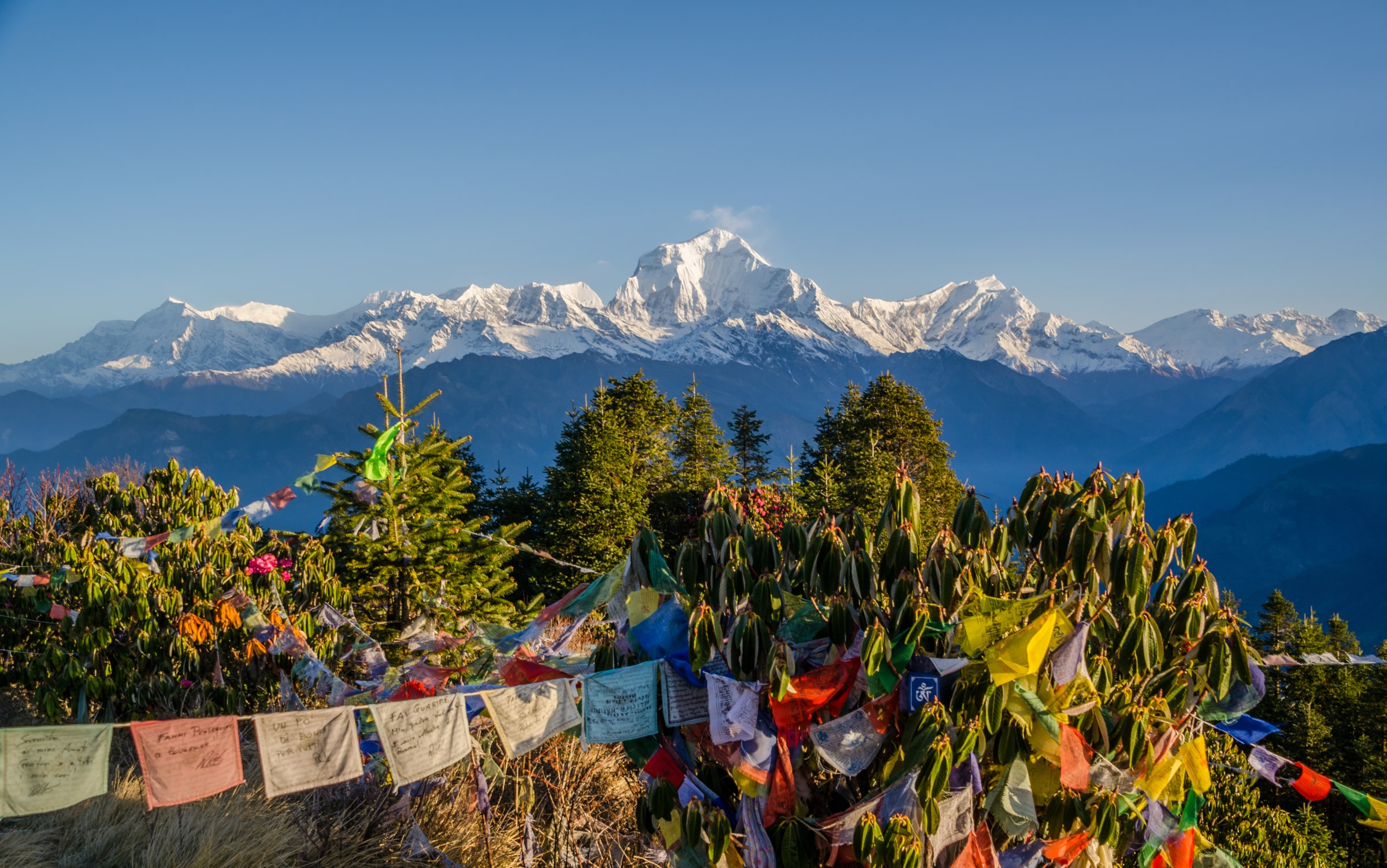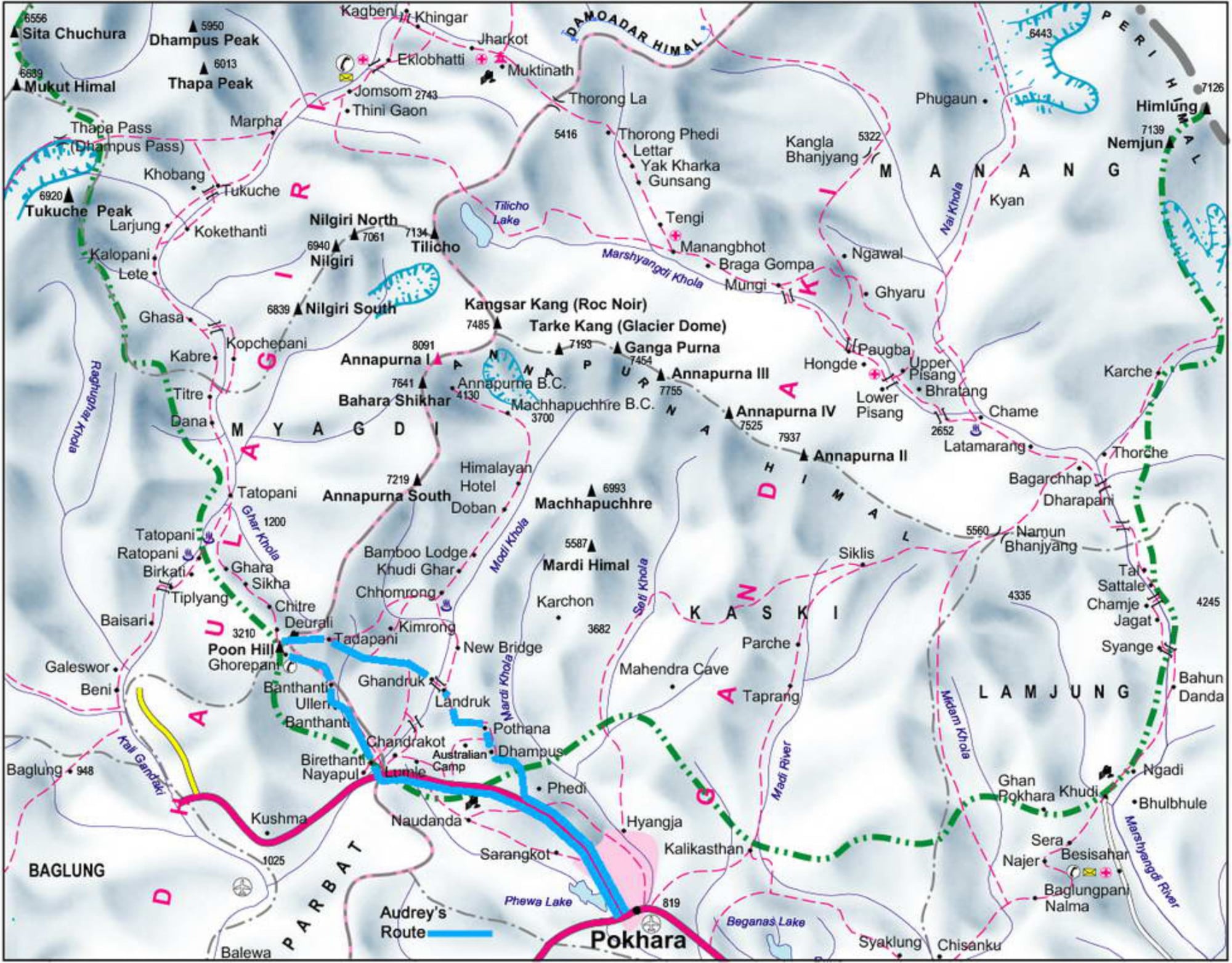
Inside Nepal: Yoga, Hiking and Cultural Exploration
Nepal
10 Days
From $4,000
Level 2 Easy-to-Moderate
Call 1-303-507-2530 or Contact Us with any questions.
Embark on a journey into the colorful tapestry of Nepalese culture, breathtaking landscapes, and the diverse flora and fauna of Chitwan National Park. Unique to this trek is the daily integration of yoga practice, which will enhance our physical ease and support mindfulness in hiking and travel.
Our experience of this land, with its natural splendor and ancient heritage, will be deepened by authentic connections with local communities and unique destinations. Amidst blooming rhododendrons, we'll hike alongside tranquil rivers and pristine lakes, traverse rustic villages, and explore the vibrant cities of Pokhara and Kathmandu. A safari in Chitwan National Park, renowned for its diverse wildlife, is a highlight of this trip.
With comfortable accommodations and the support of seasoned local guides, our small group will travel together, forging deep friendships and unforgettable memories. Prepare to be inspired and revitalized by Nepal’s unparalleled beauty and spirit on this extraordinary trek.

Day 1: Arrive in Kathmandu
Day 2: Fly to Pokhara & Trek the Landurung
Day 3: Trek from Landurung to Tolka
Day 4: Trek from Tolka to Deurali
Day 5: Trek to Kade
Day 6: Wildlife Exploration in Chitwan National Park
Day 7: Explore Chitwan National Park
Day 8: Fly to Kathmandu
Day 9: Explore Kathmandu & Ancient Bhaktapur / optional Heli-Tour
Day 10: Depart from Kathmandu
Reserving a Trip
We help to make preparing for your trip easy! Our area managers
are here to help, from choosing the right trip and checking availability to reserving your place.
Our office manager will normally be your single point of contact, overseeing all of your arrangements,
answering any questions that you may have, and helping you to prepare for the adventure of a
lifetime.
Choosing Your Trip
We suggest you read our trip information to choose the right
adventure trip for your ability and interest. Trip information is available for downloading from
each page, or they can be sent to you via fax, email, or mail. Our office manager can answer
any questions you might have, and they would be happy to refer you to someone who has traveled
with us before for a reference.
Reserving Your Place
Early reservations are recommended since group sizes are
limited and airlines often sell out their best fares many months in advance. Once you have submitted
this reservation request with us, one of our travel consultants will contact you during our next
business day to confirm your arrangements, and will charge the initial deposit to your major
credit card Visa, MasterCard, or American Express. You can download trip Application (in PDF
format) and send it to us by mail with two recent passport photos. If you have any questions,
please feel free to call us at 303-507-2530. Our office hours are Monday through Friday from
8:30AM to 5:00PM Mountain Time.
Upon receiving your deposit we will send you a confirmation
letter, detailed trip itinerary, visa information (if required), travel insurance application,
and a pre-departure information booklet with recommended equipment list, suggested reading list,
and general information needed to prepare for your trip. Our experienced staff is happy to assist
you in your preparation for your adventure with us.
| Price |
|---|
| $5000 / per person |
| Single supplement: $600 |
| $1000 discount per person, if we receive reservation before September 30th, 2024. |
| Dates | Status | |
|---|---|---|
| April 7 - 16, 2025 | Space Available | Book Now |
Price includes:
All ground transportation including airport pick up and drop
off
All necessary government permits and national park fees
All sightseeing fees noted
in the itinerary
3 nights in a Kathmandu hotel
Domestic airfare
All accommodations
Guides and all necessary potters
3 healthy meals a day (breakfast, lunch and dinner)
All hot beverages such as coffee and tea
All airport taxes
Waterproof duffel bag
Hiking t-shirt
Price does not include:
International airfare
Visa fees and travel insurance
Any medical costs
Gratuities for staff
Meals in Kathmandu
Alcoholic beverages, laundry
and showers
1. Buy your boots early and start hiking and training in them. I can't stress the importance of this enough. You want
to have your boots broken in weeks or months before your trek. Go to a reputable good gear shop
where they can help fit you for the ideal, high-quality boot and then start wearing them everywhere!
Trust me, you don't want to suffer blisters on the trek because you skimped on boot preparation.
Wear them around the kitchen, to work and then to train in.
*Buy your boots early and start hiking and training in them.
2. When you trek in Nepal, there are going
to be hills and steps to climb (no surprises there), so make sure your training isn't all
on flat ground. Find trails with steep sections and/or steps to climb. If you don't have any
steep trails near home, jump on a stair-master at the gym. (Wear your boots) You may have 4,
5, 6 or more hour days so, you will benefit by gradually working up to longer days in those boots
and with a pack. A long 3-4 hour hike, once a week starting 2 months before the Trek should give
you a good base of fitness so that you will enjoy each day of trekking. (For the October Trek,
start in August. For the March Trek, start in January)
*At least one long 3-4 hour hike, per week, starting 2 months before
3.
Any type of cardiovascular conditioning is good training for Everest Base Camp. Your days will
be spent walking rolling hills with a small pack. Some days will have tough up-hills so the more
training the better. Up-hills at higher elevation will inherently feel more exhausting. Shortness
of breath at altitude is the toughest thing to train for. The key will be taking it slow. Running,
rowing, cycling, and walking up-hills are all a great way to build your endurance. Mix it up
and choose the exercise you enjoy the most. Progression is important so start out easy and work
up to 3-4 times a week of 30-45 minutes of moderately strenuous cardiovascular workouts.
*30-45 minutes of moderate cardiovascular, 3-4 times a week
4. Strength
Training is always beneficial and having strong legs and back will make the hiking and carrying
your pack easier. A 30 minute total body workout 2x per/week is sufficient with maybe a little
more focus on your legs and back. You could add this on the same days as your cardio or you could
do it separately, depending on time. There are lots of options for a good strength workout but
here are a few basic exercises that would work well for the Trek. 1-2 sets of 12-15 reps.
Squats
Lunges
Leg Extensions
Leg Curl Machines
Seated Pull-Downs (for the back)
Seated Row
(for the back)
Crunches or Abdominal workouts
*30 minutes total body workout, 2 times a week
Recommended Trekking Gear List
The items listed here are essential to have
for the trip but there are a few "nice to have" optional items that are also listed.
Please feel free to reach out for additional information or recommendations.
First Layer Clothing
Base layer top (2) - 1 synthetic for day, 1 for night (can
be cotton for comfort)
Base layer bottom (1 or 2 synthetic)
T-shirts (2 or up to you)
Mid-layer long sleeved shirt (1 or 2 synthetic material like polyester or polypropylene)
Hiking shorts (2 pairs - synthetic or cotton)
Underwear (breathable, how many is up to you)
Travel clothes to wear around Katmandu before and after the trek (these can be left at the hotel
in secured storage)
Outer Layer Clothing
Fleece jacket, soft-shell jacket or wool top
Soft-shell
long pants or trekking pants
Gore-Tex or other breathable waterproof jacket
Gore-Tex
or equivalent breathable waterproof rain pants
Down Jacket - synthetic is ok, must be very
warm and puffy for night, camping, and rests (if you tend to get cold easily, get a warmer, heavier
jacket (temps could range from 0-30 degrees)
Wool or fleece hat
Buff
Waterproof gloves (softshell)
Warm mittens (for colder nights)
Optional lightweight
gloves (glove liners)
Sun hat (baseball cap, safari hat, something to keep the sun off)
Gear
Small daypack (30-40 liter) - an internal frame backpack is best and bookbag
types are not recommended (there are many quality brands to choose from including Osprey, Deuter,
North Face, Gregory, Red Fox, to name a few)
Sleeping bag - down or synthetic 0-20 degrees
(Fahrenheit)
Sunglasses 100% UV (glacier type that wrap around and give more protection to
the eyes)
Headlamp (small LED models with spare batteries)
SUNSCREEN: waterproof, SPF
30 or higher, broad spectrum (2-3oz tube)
Sunscreen lip balm, SPF 15 or higher
2 water
bottles (1 quart Nalgene bottles are best)
Pocket knife (e.g., a Swiss Army Knife - very
handy!)
Trash bags (3 - for separating out your dirty laundry and organizing)
A large
expedition bag will be provided by SMA upon arrival in Nepal. You can use your own expedition
bag or luggage to carry your items over there, then borrow the SMA expedition bag.
Personal Items
Toiletry kit to include:
Toothbrush
Toothpaste
Small soap (1- 2 oz. plastic bottle of something like Dr. Bronner’s soap)
Shower towel
Shampoo
Glasses or contacts, as needed
Any necessary medications
3 zip-loc bags (1 large
for a notebook, 2 any size for miscellaneous use)
Optional Trekking poles
Optional Compass,
star-chart, or binoculars
Optional Camera (batteries and a charger)
Optional External
power brick (for charging phone/iPod)
Optional Journal/notebook and pen
Optional Any
munchies you can’t get along without (e.g., chocolate, energy bars)
Optional Personal first
aid kit (for blister care, etc.) *SMA Guides will have a well-equipped group supply of basic
first aid and medications that will always be with us.
One of the most important items
you will have for trekking is….Your BOOTS! The best boots for this trip are quality,
light to medium-weight hiking boots that are waterproof. Go to a reputable gear shop and help
get fitted for the ideal boot. You will be in them most of the day so get the right ones that
fit you! (Scarpa, Lowa, LaSportiva, Salewa, Merrell, Asolo, Vasque are the best brands)
New
boots MUST be broken in prior to coming to the trip. Breaking in a new pair of boots can involve
several weeks so make sure you do it early and well before you arrive in Nepal!
Footwear
Light to medium weight hiking boots that are waterproof!
Sport
sandals (such as Tevas or Chacos, Crocs) or lightweight running shoes for at camp (using bathroom
at night, chilling in teahouse) Sport sandals, such as Tevas, Crocks, or Chacos, work very well
for this and can be used for stream crossings in the backcountry. Running shoes also work well
but do not dry as quickly. Thick wool socks (3 pairs)
Optional Liner socks (2 pairs of thin
wool, polypro, Thermax, or similar - not cotton!)
Optional Down booties- totally luxurious
but nice for walking around at the Teahouses
